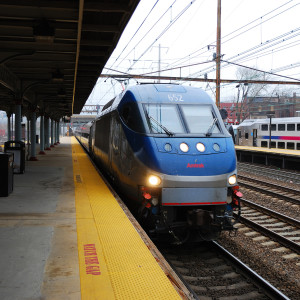Randal O’Toole understands how you feel about trains. He’s just trying to get you to understand that everything you’re feeling, is wrong.
“Americans often go to Europe and they ride the high speed trains–and I’m no exception–and they’ll ride the trams and the underground and the conventional trains and they’ll come back to the United States saying, ‘Why don’t we have a great train system like Europe?'” says O’Toole, a senior fellow at the Cato Institute and author of the new book Romance of the Rails: Why the Passenger Trains We Love Are Not the Transportation We Need.
“The reality is trains don’t work that well in Europe either.”
Speaking at a Cato Institute event, O’Toole noted that, while Europeans do travel more by rail than Americans do– an average of 600 miles per year vs. 100 annual miles per American–they travel less overall. The primary reason is that Europeans only travel an average of 6,000 miles per year by car, while Americans average 15,000 per year. This disparity has a dramatic effect on how our cities are built and the sort of infrastructure we need.
Another major difference is how we use rail. In America, rail is dominated by freight traffic, while in Europe it’s primarily a way to move people. This focus on passenger transit has pushed freight loads off of the tracks and on to Europe’s roads. Only about 11 percent of freight goes by rail in Europe. In Japan, another hub of passenger trains, it is even lower, at 4.5 percent.
“By deciding to run their rail system for passengers, they are actually using a lot more energy,” says O’Toole. This is because trains are a highly efficient way of moving very heavy cargoes long distances.
As a senior fellow at a libertarian think tank, it’s hardly surprising that O’Toole opposes government subsidizes of rail and instead favors letting the free market determine which sections of track are profitable enough to continue to operate.
While simple in theory, this approach could hurt much of rural America, says Art Guzzetti, vice president of policy at the American Public Transportation Association.
“Not every highway can be a toll road, somewhat similarly, not every private rail corridor is ripe for private operation,” he said, explaining that some roads are provided for the good of the citizens, even though they might not be able to support themselves.
Guzzetti and other supporters of rail, especially urban rail systems, argue that as America’s population grows and continues to center around urban areas, there will be a continued need for transit options that can move more people with less space. And no, self-driving cars will not be the panacea.
“A car creates congestion whether it is driven by a robot or a person, so self-driving cars will not solve congestion on their own,” said Jim Matthews, president of the Rail Passengers Association.
Unfortunately neither will light rail. Not only is light rail relatively expensive compared to other options, such as buses, it also has limited passenger capacity. Light rail trains that run on the streets are limited to only 2-3 cars, carrying a maximum of about 12,000 people per hour, while buses in cities like Portland, Ore. can move 20,000 people an hour. Buses are also cheaper to purchase and to operate.
Defenders of passenger rail argue that benefits like allowing senior citizens and rural residents to travel safely are worth subsidizing. Opponents of subsidies disagree, pointing out that, particularly in the era of Uber, there are many other transportation options more flexible (and less expensive) than fixed rail.
And do passengers even want to ride trains? In certain areas, like Florida, where Brightline, a private company, offers rail service between several cities, it looks like they do. In other parts of the country, that may not be the case. It is a question of quality in addition to pricing and customers will vote with their pocketbooks. After all, judging just by the miles, Americans travel 150 times further by car each year than they do by train and twice as far just on domestic flights. In a world where time is money, trains are frequently too slow–A coast to coast trip on Amtrak takes several days, compared to a five hour plane ride.
O’Toole was particularly blunt about this:
“I rode Amtrak coast to coast three times last year. I found the coach seats to be torturous. I found the sleeping cars to be one-star hotels at five-star prices. I found the food to be mediocre at best and it would have done shame to a Denny’s. I found the onboard personnel to be very friendly… but it was not an experience I am eager to do again.”
Is that really an experience worth subsidizing?

